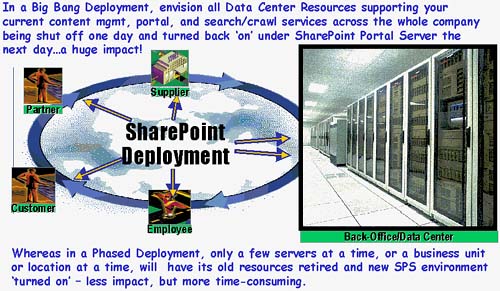| While Global's enterprise portal goals are many, such a huge enterprise undertaking must still start with a single footstep toward planning. An infinite number of approaches are of course available. Many enterprise deployments actually start out as successful department-wide or small-business-unit deployments. However, in the case of new-implementation methodologies to deployment planning for enterprise portal applications, two approaches stand out (see Figure 22.2). Figure 22.2. Experience shows that large portal implementations are best accomplished in increments .  Requirements for the portal tend to evolve along with the business, so it only makes sense that new subject areas, capabilities, and dimensions be added incrementally, hence the term deploy as you go. The Phased Deployment Approach The first, a "Phased Deployment," refers to rolling out the new Portal application across one or a few business units or geographies, and is sometimes called a "deploy as you go" strategy. This allows for a relatively rapid implementation of at least part of the overall Portal solution, but also requires that legacy systems remain available to address features or needs not yet handled by the new solution. As such, this is a good way to go when it is important to show ROI quickly, but this method also requires a longer overall deployment time than the next option. The Big Bang Approach The second approach, the "Big Bang," requires a much longer development phase and more complicated roll-out phase, but allows the entire organization to benefit from immediate access to the same system. This second approach allows legacy systems to be retired much more quickly, reducing and possibly eliminating the time required for "parallel operations." The Big Bang, however, also tends to suffer more from scope and version-creep, and therefore must be managed aggressively to stay on target. Plus, it's a riskier approach overall, given the potential impact a failed implementation may pose. However, to its greatest benefit, the Big Bang approach to enterprise deployments tends to roll out faster than a similar Phased Deployment approach, where downtime is required to support the addition of new capabilities related to each phase. Global and the Phased Deployment Approach First off, for Global, the timing on a number of different fronts was such that it made more sense to go with a phased approach. That is, quite a few of the business units were in a position to leverage a SharePoint Portal Server solution, given that half of the end- user clients were recently upgraded to new technology. Second, a number of these business groups would benefit tremendously from simple search capabilities, of which they had none. In fact, the end users of one of the largest manufacturing facilities ”MANX ”were especially anxious to actually leverage the well-publicized capabilities of Office XP combined with SharePoint Portal Server! Third, given that two of the three Data Centers were in a position to terminate leases of proprietary and nonstandard DMS computing gear in the next two months, timing was considered ideal for supporting the architecture, design, and installation of new servers and infrastructure underpinning the SharePoint project. And finally, anything but a phased approach seemed just too risky, and too inclined to suffer from scope-creep, in such a large company spread out across the globe. Global's MANX Pilot Given the previous, and a corporate mandate to "make it happen," the Project Steering Committee (consisting of business group executive representatives and a preliminary technical support organization) made a strategic decision to get the ball rolling quickly. An initial pilot project supporting the large MANX facility made sense to everyone, and a general budget figure was nailed down. Consisting of 1,000 users, it was by no means a small pilot, but it would represent a critical "win" once productive. And such a large body of eager end users would prove key to making the overall project successful, as well as providing a wonderful test-bed for demonstrating SharePoint Portal Server's capabilities and real-world limitations and challenges. The extensibility of an initial SharePoint Portal Server deployment was one factor not mentioned beforehand that was also especially appealing to the business folks. That is, they knew that the initial SharePoint Portal Server deployment would provide great value for the MANX organization, but they also believed that they would quickly discover additional uses for SPS not yet envisioned . Features like the ability to add and customize workspaces for different groups, or to facilitate the creation of a corporate dashboard site linking what would eventually become many business group dashboard sites, held great promise for the initial pilot. They knew that consolidating their data and information sources and leveraging SharePoint Portal's document management capabilities would not only change the way they managed projects, but also how they simply worked together to achieve the company's goals. |

